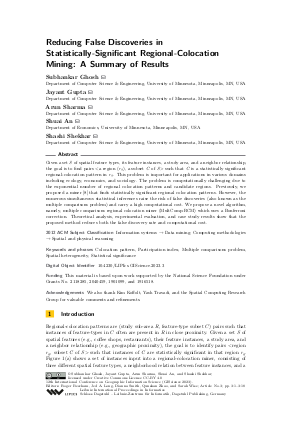Reducing False Discoveries in Statistically-Significant Regional-Colocation Mining: A Summary of Results
Authors Subhankar Ghosh, Jayant Gupta, Arun Sharma, Shuai An, Shashi Shekhar
-
Part of:
Volume:
12th International Conference on Geographic Information Science (GIScience 2023)
Part of: Series: Leibniz International Proceedings in Informatics (LIPIcs)
Part of: Conference: International Conference on Geographic Information Science (GIScience) - License:
 Creative Commons Attribution 4.0 International license
Creative Commons Attribution 4.0 International license
- Publication Date: 2023-09-07
File

PDF
LIPIcs.GIScience.2023.3.pdf
- Filesize: 3.69 MB
- 18 pages
Document Identifiers
Subject Classification
ACM Subject Classification
- Information systems → Data mining
- Computing methodologies → Spatial and physical reasoning
Keywords
- Colocation pattern
- Participation index
- Multiple comparisons problem
- Spatial heterogeneity
- Statistical significance
Metrics
- Access Statistics
-
Total Accesses (updated on a weekly basis)
0Document
0Metadata
Abstract
Given a set S of spatial feature types, its feature instances, a study area, and a neighbor relationship, the goal is to find pairs <a region (r_{g}), a subset C of S> such that C is a statistically significant regional-colocation pattern in r_{g}. This problem is important for applications in various domains including ecology, economics, and sociology. The problem is computationally challenging due to the exponential number of regional colocation patterns and candidate regions. Previously, we proposed a miner [Subhankar et. al, 2022] that finds statistically significant regional colocation patterns. However, the numerous simultaneous statistical inferences raise the risk of false discoveries (also known as the multiple comparisons problem) and carry a high computational cost. We propose a novel algorithm, namely, multiple comparisons regional colocation miner (MultComp-RCM) which uses a Bonferroni correction. Theoretical analysis, experimental evaluation, and case study results show that the proposed method reduces both the false discovery rate and computational cost.
Cite As Get BibTex
Subhankar Ghosh, Jayant Gupta, Arun Sharma, Shuai An, and Shashi Shekhar. Reducing False Discoveries in Statistically-Significant Regional-Colocation Mining: A Summary of Results. In 12th International Conference on Geographic Information Science (GIScience 2023). Leibniz International Proceedings in Informatics (LIPIcs), Volume 277, pp. 3:1-3:18, Schloss Dagstuhl – Leibniz-Zentrum für Informatik (2023)
https://doi.org/10.4230/LIPIcs.GIScience.2023.3
BibTex
@InProceedings{ghosh_et_al:LIPIcs.GIScience.2023.3,
author = {Ghosh, Subhankar and Gupta, Jayant and Sharma, Arun and An, Shuai and Shekhar, Shashi},
title = {{Reducing False Discoveries in Statistically-Significant Regional-Colocation Mining: A Summary of Results}},
booktitle = {12th International Conference on Geographic Information Science (GIScience 2023)},
pages = {3:1--3:18},
series = {Leibniz International Proceedings in Informatics (LIPIcs)},
ISBN = {978-3-95977-288-4},
ISSN = {1868-8969},
year = {2023},
volume = {277},
editor = {Beecham, Roger and Long, Jed A. and Smith, Dianna and Zhao, Qunshan and Wise, Sarah},
publisher = {Schloss Dagstuhl -- Leibniz-Zentrum f{\"u}r Informatik},
address = {Dagstuhl, Germany},
URL = {https://drops.dagstuhl.de/entities/document/10.4230/LIPIcs.GIScience.2023.3},
URN = {urn:nbn:de:0030-drops-188985},
doi = {10.4230/LIPIcs.GIScience.2023.3},
annote = {Keywords: Colocation pattern, Participation index, Multiple comparisons problem, Spatial heterogeneity, Statistical significance}
}
Author Details
- Department of Computer Science & Engineering, University of Minnesota, Minneapolis, MN, USA
- Department of Computer Science & Engineering, University of Minnesota, Minneapolis, MN, USA
- Department of Computer Science & Engineering, University of Minnesota, Minneapolis, MN, USA
Funding
This material is based upon work supported by the National Science Foundation under Grants No. 2118285, 2040459, 1901099, and 1916518.
Acknowledgements
We also thank Kim Koffolt, Yash Travadi, and the Spatial Computing Research Group for valuable comments and refinements.
References
-
Sajib Barua and Jörg Sander. Mining statistically significant co-location and segregation patterns. IEEE TKDE, 26(5):1185-1199, 2013.

-
Julian Besag and Peter J Diggle. Simple monte carlo tests for spatial pattern. Journal of the Royal Statistical Society: Series C (Applied Statistics), 26(3):327-333, 1977.

-
Carlo Bonferroni. Teoria statistica delle classi e calcolo delle probabilita. Pubblicazioni del R Istituto Superiore di Scienze Economiche e Commericiali di Firenze, 8:3-62, 1936.

-
M Celik et al. Zonal co-location pattern discovery with dynamic parameters. ICDM, 2007.

-
Min Deng et al. Multi-level method for discovery of regional co-location patterns. IJGIS, 2017.

-
Wouter Duivesteijn and Arno Knobbe. Exploiting false discoveries-statistical validation of patterns and quality measures in subgroup discovery. In 2011 IEEE 11th International Conference on Data Mining, pages 151-160. IEEE, 2011.

-
Christoph F. Eick, Rachana Parmar, et al. Finding regional co-location patterns for sets of continuous variables in spatial datasets. In SIGSPATIAL, 2008.

-
Subhankar et. al. Towards geographically robust statistically significant regional colocation pattern detection. In Proceedings of the 5th ACM SIGSPATIAL GeoSIM, pages 11-20, 2022.

-
Yan Li et al. Cscd: Towards spatially resolving the heterogeneous landscape of mxif oncology data. In Proceedings of the 10th ACM SIGSPATIAL International Workshop on Analytics for Big Geospatial Data, BigSpatial '22, pages 36-46, New York, NY, USA, 2022. ACM.

-
Yan Huang et al. Discovering colocation patterns from spatial data sets: a general approach. IEEE TKDE, 16(12):1472-1485, 2004.

-
Janine Illian, Antti Penttinen, et al. Statistical analysis and modelling of spatial point patterns, volume 70. John Wiley & Sons, 2008.

-
Yan Li and Shashi Shekhar. Local co-location pattern detection: a summary of results. In GIScience. Schloss Dagstuhl-Leibniz-Zentrum fuer Informatik, 2018.

-
Guenter B Risse. "A long pull, a strong pull, and all together": San francisco and bubonic plague, 1907-1908. Bulletin of the History of Medicine, 66(2):260-286, 1992.

-
G Rupert Jr et al. Simultaneous statistical inference. Springer Science & Business Media, 2012.

-
Arun Sharma, Jayant Gupta, and Subhankar Ghosh. Towards a tighter bound on possible-rendezvous areas: preliminary results. In Proceedings of the 30th International Conference on Advances in Geographic Information Systems, pages 1-11, 2022.

-
Shashi Shekhar and Yan Huang. Discovering spatial co-location patterns: A summary of results. In Intl. symposium on spatial and temporal databases, pages 236-256. Springer, 2001.

-
Song Wang et al. Regional co-locations of arbitrary shapes. In SSTD, 2013.

-
Geoffrey I Webb. Discovering significant patterns. Machine learning, 68(1):1-33, 2007.

-
David WS Wong. The modifiable areal unit problem (maup). In WorldMinds: geographical perspectives on 100 problems: commemorating the 100th anniversary of the association of American geographers 1904-2004, pages 571-575. Springer, 2004.

